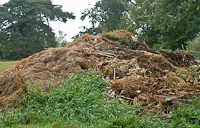 As the name implies, this is a method that takes very little
effort. It is the method used by farmers for centuries with
their mould board plows. They simply turned the soil over and
buried the plant litter in the ground where it would slowly
decompose.
As the name implies, this is a method that takes very little
effort. It is the method used by farmers for centuries with
their mould board plows. They simply turned the soil over and
buried the plant litter in the ground where it would slowly
decompose.
In the backyard garden or
landscape, passive composting may be a little trickier but it
can be done. The key is that you need to have a way to
incorporate the trimmings, clippings and dead plants into the
soil without disturbing too many of the roots of established
perennials, shrubs or trees.
When preparing new perennial beds
or in the yearly preparation of beds for
annuals, simply shred
or cut your yard waste into as small sized pieces as possible.
In new beds or borders, you can put 3 or 4 inches of small
particle organic matter on top of the soil and dig it into the
topsoil about 8 to 10 inches deep.
As the organic matter decomposes
in the soil, it will use some
nitrogen. However, studies
indicate that this should not pose a big problem in general. If
your plants show nitrogen deficiency symptoms, simply apply some
supplemental fertilizer or other nitrogen source.
You might experience some
mushrooms as the organic material decays. Simple ignore these or
rake them away. They will stop once the decaying process is
complete.



